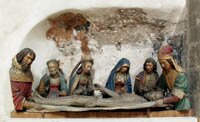 The Pharisees (from the Hebrew perushim, from parash, meaning "to separate") were, depending on the time, a political party, a social movement, and a school of thought among Jews that flourished during the Second Temple Era (536 BCE–70 CE). After the destruction of the Second Temple, the Pharisaic sect was re-established as Rabbinic Judaism — which ultimately produced normative, traditional Judaism, the basis for all contemporary forms of Judaism. The relationship between the Pharisees and Rabbinic Judaism (exemplified by the Talmud) is so close that many do not distinguish between the two.
The Pharisees (from the Hebrew perushim, from parash, meaning "to separate") were, depending on the time, a political party, a social movement, and a school of thought among Jews that flourished during the Second Temple Era (536 BCE–70 CE). After the destruction of the Second Temple, the Pharisaic sect was re-established as Rabbinic Judaism — which ultimately produced normative, traditional Judaism, the basis for all contemporary forms of Judaism. The relationship between the Pharisees and Rabbinic Judaism (exemplified by the Talmud) is so close that many do not distinguish between the two.Nevertheless, the social standing and beliefs of the Pharisees changed over time, as political and social conditions in Judea changed. It is thus impossible to understand the Pharisees without understanding their historical context.
More...


No comments:
Post a Comment